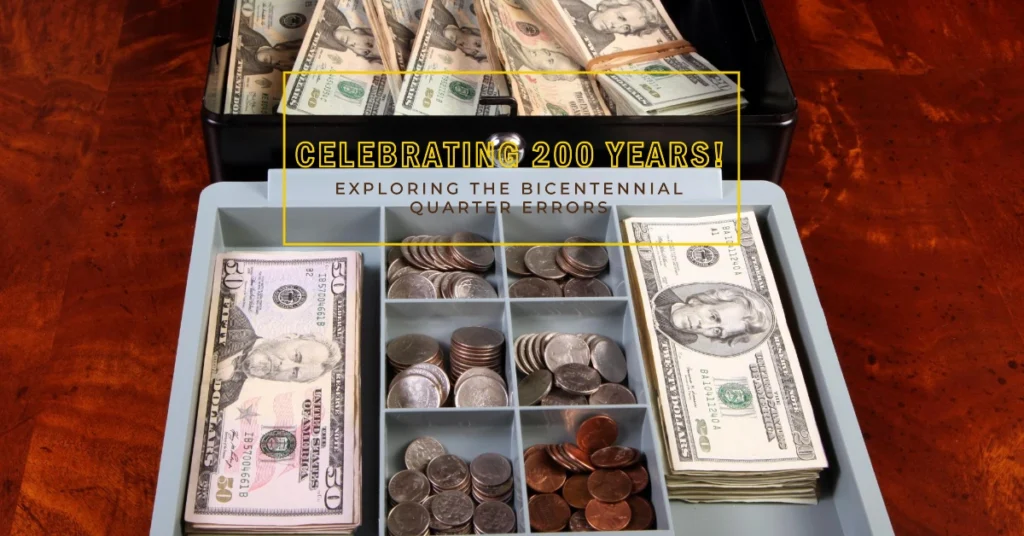The 1976 Bicentennial quarters, issued to celebrate the 200th anniversary of American independence, have become iconic coins in U.S. history. While millions were produced, error coins from this series are highly sought after by collectors due to their rarity and unique imperfections. From doubled dies to off-center strikes, these error quarters hold significant value and have become a collector’s dream. Let’s explore some of the most notable Bicentennial quarter errors and why they are prized by numismatists.
Table of Contents
1. Doubled Die Obverse (DDO)
One of the most famous errors in coin collecting, the Doubled Die Obverse (DDO) occurs when the coin’s design is impressed twice onto the planchet (the blank metal disc), causing a visible doubling of details. For the 1976 Bicentennial quarter, a DDO can appear on the obverse (front side), where George Washington’s profile, particularly his face and the date “1776-1976,” may show slight overlapping or doubling. These errors are highly valued due to their rarity and the visual distinction they provide. Collectors should carefully examine the obverse of their Bicentennial quarters for signs of doubling around Washington’s hair, eyes, and the lettering.
2. Off-Center Strike
An off-center strike occurs when the coin is not properly aligned with the minting dies, resulting in a quarter that appears cut off or missing part of its design. For Bicentennial quarters, off-center strikes can range from slight misalignments to coins that are missing as much as 50% of the design. The more severe the misalignment, the rarer the coin. Off-center Bicentennial quarters are especially prized because they offer a distinct visual error that makes the coin instantly recognizable to collectors.

3. Clipped Planchet
A clipped planchet occurs when part of the blank metal disc used to mint the coin is improperly cut, resulting in a quarter with a crescent-shaped clip missing from the edge. This error can vary in severity, with some coins missing small portions and others missing significant parts of the rim. Clipped planchet Bicentennial quarters are a rarity and fetch higher prices due to the noticeable and unusual nature of the error.
4. Broadstruck Quarter
A broadstruck error occurs when a coin is struck without the collar die, which usually holds the coin in place during the minting process. As a result, the quarter appears to have a larger diameter and a distorted design, as the metal flows outward without the restriction of the collar. Bicentennial broadstruck quarters are especially appealing to collectors for their odd size and stretched appearance, making them a striking addition to any collection.
5. Die Breaks and Cuds
Die breaks happen when the minting die cracks or chips, causing raised lines or blobs of metal to appear on the finished coin. A more significant die break can lead to a “cud,” where a large piece of the die is broken off, resulting in a raised area of metal filling in part of the coin’s design. Bicentennial quarters with noticeable die breaks or cuds are rare and can attract higher prices. Collectors should look for these raised imperfections, especially around the coin’s rim or design elements like the colonial drummer on the reverse side.
6. Wrong Planchet Error
One of the rarest and most valuable types of errors is the wrong planchet error, where a Bicentennial quarter is mistakenly struck on a planchet intended for another coin, such as a dime or a foreign coin. These quarters may appear smaller or have a different metal composition. The wrong planchet error is incredibly scarce, and Bicentennial quarters with this mistake can sell for thousands of dollars due to their extreme rarity and the unusual appearance of the coin.
Top 5 Rare Bicentennial Quarters to Add to Your Collection
The Design and Minting of Bicentennial Coins
Bicentennial Budgeting: How Americans Managed Finances in 1976
How to Identify and Value Bicentennial Quarter Errors
Collectors looking to find error Bicentennial quarters should carefully examine their coins with a magnifying glass, paying close attention to the details on both the obverse and reverse sides. Common signs of errors include doubling of images, unusual shapes, missing elements, or raised blobs of metal.
The value of error Bicentennial quarters depends on several factors:
- Rarity: The scarcer the error type, the more valuable the coin.
- Condition: Coins in better condition, particularly those with minimal wear, will fetch higher prices.
- Severity of the Error: The more extreme the error (e.g., a severe off-center strike or a large die break), the more valuable the coin.
Prices for Bicentennial quarter errors can range from modest premiums for minor errors to thousands of dollars for rare mistakes like the wrong planchet or dramatic off-center strikes. Collectors can consult numismatic guides, attend coin shows, or visit online marketplaces to gauge the current value of specific error coins.
A Treasure for Collectors
Bicentennial quarter errors are a collector’s dream due to their rarity, historical significance, and unique visual appeal. These coins, often overlooked in everyday change, can carry significant value for those who know what to look for. Whether you find a doubled die, an off-center strike, or a rare wrong planchet error, these Bicentennial quarter errors offer a glimpse into the fascinating world of numismatic imperfections and make a treasured addition to any coin collection.
Leave a Reply